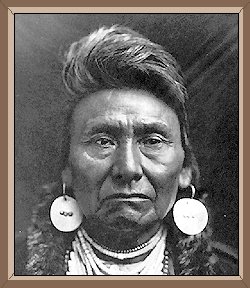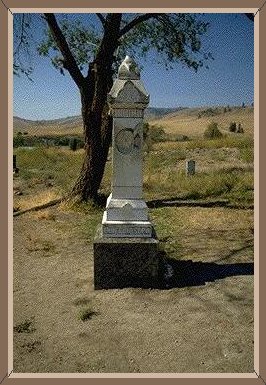|

Chief Joseph
Hin-mah-too-yah-lat-kekt
(1840-1904)
The man who became a national celebrity with the name "Chief
Joseph" was born in the Wallowa Valley in what is now
northeastern Oregon in 1840. He was given the name
Hin-mah-too-yah-lat-kekt, or Thunder Rolling Down the
Mountain, but was widely known as Joseph, or Joseph the
Younger, because his father had taken the Christian name
Joseph when he was baptized at the Lapwai mission by Henry
Spalding in 1838.
Joseph the Elder was one of the first Nez PercÚ converts to
Christianity and an active supporter of the tribe's longstanding
peace with whites. In 1855 he even helped Washington's
territorial governor set up a Nez PercÚ reservation that stretched
from Oregon into Idaho. But in 1863, following a gold rush into
Nez PercÚ territory, the federal government took back almost six
million acres of this land, restricting the Nez PercÚ to a
reservation in Idaho that was only one tenth its prior size. Feeling
himself betrayed, Joseph the Elder denounced the United States,
destroyed his American flag and his Bible, and refused to move
his band from the Wallowa Valley or sign the treaty that would
make the new reservation boundaries official.
When his father died in 1871, Joseph was elected to succeed
him. He inherited not only a name but a situation made
increasingly volatile as white settlers continued to arrive in the
Wallowa Valley. Joseph staunchly resisted all efforts to force his
band onto the small Idaho reservation, and in 1873 a federal
order to remove white settlers and let his people remain in the
Wallowa Valley made it appear that he might be successful. But
the federal government soon reversed itself, and in 1877 General
Oliver Otis Howard threatened a cavalry attack to force Joseph's
band and other hold-outs onto the reservation. Believing military
resistance futile, Joseph reluctantly led his people toward Idaho.
Unfortunately, they never got there. About twenty young Nez
PercÚ warriors, enraged at the loss of their homeland, staged a
raid on nearby settlements and killed several whites. Immediately,
the army began to pursue Joseph's band and the others who had
not moved onto the reservation. Although he had opposed war, Joseph cast his lot with the war leaders.
What followed was one of the most brilliant military retreats in
American history. Even the unsympathetic General William
Tecumseh Sherman could not help but be impressed with the
1,400 mile march, stating that "the Indians throughout displayed
a courage and skill that elicited universal praise... [they] fought
with almost scientific skill, using advance and rear guards,
skirmish lines, and field fortifications." In over three months, the
band of about 700, fewer than 200 of whom were warriors,
fought 2,000 U.S. soldiers and Indian auxiliaries in four major
battles and numerous skirmishes.
By the time he formally surrendered on October 5, 1877, Joseph
was widely referred to in the American press as "the Red
Napoleon." It is unlikely, however, that he played as critical a role
in the Nez PercÚ's military feat as his legend suggests. He was
never considered a war chief by his people, and even within the
Wallowa band, it was Joseph's younger brother, Olikut, who led
the warriors, while Joseph was responsible for guarding the
camp. It appears, in fact, that Joseph opposed the decision to flee
into Montana and seek aid from the Crows and that other chiefs
-- Looking Glass and some who had been killed before the
surrender -- were the true strategists of the campaign.
Nevertheless, Joseph's widely reprinted surrender speech has
immortalized him as a military leader in American popular
culture:
I am tired of fighting. Our chiefs are killed. Looking Glass is dead.
Toohoolhoolzote is dead. The old men are all dead. It is the young
men who say, "Yes" or "No." He who led the young men [Olikut] is
dead. It is cold, and we have no blankets. The little children are
freezing to death. My people, some of them, have run away to the
hills, and have no blankets, no food. No one knows where they are --
perhaps freezing to death. I want to have time to look for my
children, and see how many of them I can find. Maybe I shall find
them among the dead. Hear me, my chiefs! I am tired. My heart is
sick and sad. From where the sun now stands I will fight no more
forever.
Joseph's fame did him little good. Although he had surrendered
with the understanding that he would be allowed to return home,
Joseph and his people were instead taken first to eastern Kansas
and then to a reservation in Indian Territory (present-day
Oklahoma) where many of them died of epidemic diseases.
Although he was allowed to visit Washington, D.C., in 1879 to
plead his case to U.S. President Rutherford B. Hayes, it was not
until 1885 that Joseph and the other refugees were returned to
the Pacific Northwest. Even then, half, including Joseph, were
taken to a non-Nez PercÚ reservation in northern Washington,
separated from the rest of their people in Idaho and their
homeland in the Wallowa Valley.
In his last years, Joseph spoke eloquently against the injustice of
United States policy toward his people and held out the hope that
America's promise of freedom and equality might one day be
fulfilled for Native Americans as well. An indomitable voice of
conscience for the West, he died in 1904, still in exile from his
homeland, according to his doctor "of a broken heart."
Chief Joseph is buried in the Colville Indian Cemetery just north of Nespelem, Washington.

BACK |